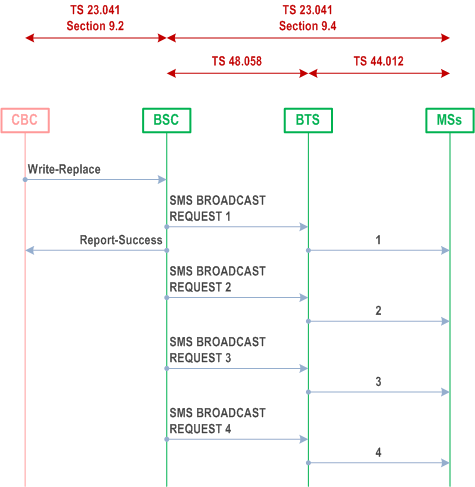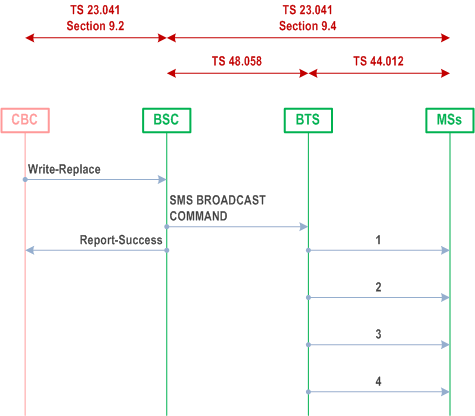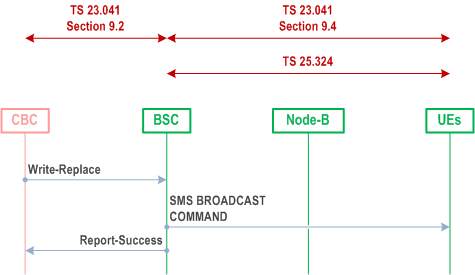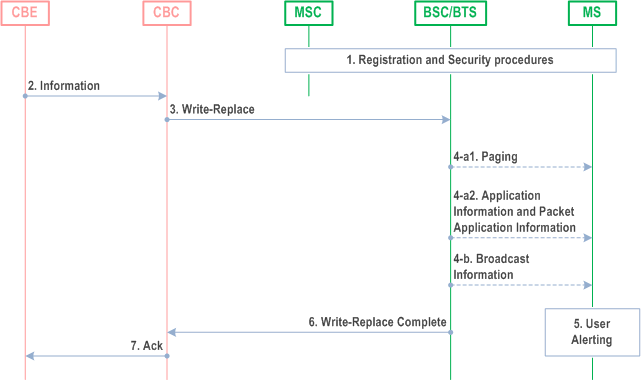Content for TS 23.041 Word version: 18.6.0
1…
2
3…
4…
6…
9…
9.1.3.3
9.1.3.4…
9.1.3.5…
9.1.4…
9.2…
9.2.10…
9.2.21…
9.3…
9.3.20…
9.3.40…
9.4…
9.4.2…
9.5
9A…
10…
B…
9 Protocols and Protocol Architecture
9.1 Requirements on Core Network and Radio Access Network
9.1.1 GSM Radio Access Network
9.1.2 UMTS Radio Access Network
9.1.3 Warning Message Delivery
9.1.3.1 General
9.1.3.2 Warning Message Delivery Procedure in GSM
...
...
9 Protocols and Protocol Architecture p. 20
9.1 Requirements on Core Network and Radio Access Network p. 20
9.1.1 GSM Radio Access Network p. 20
Commands interpreted by the BSC will result in a sequence of 4 SMS BROADCAST REQUEST messages or 1 SMS BROADCAST COMMAND message being sent to a BTS, which in turn result in a sequence of 4 blocks each 22 octets long being transferred via the BTS-MS interface (see TS 44.012).
With the SMS BROADCAST REQUEST mode of operation, the 88 octet fixed length CBS page which is specified in clause 9.3 is split into four 22 octet blocks which are carried in SMS BROADCAST REQUEST messages as follows:
octets 1-22:
Figure 3 illustrates the protocol architecture and the scope of the various GSM Specifications for the SMS BROADCAST REQUEST mode of operation.
are transferred in the 1st SMS BROADCAST REQUEST with a sequence number (see TS 44.012) indicating first block;
octets 23-44:
are transferred in the 2nd SMS BROADCAST REQUEST with a sequence number (see TS 44.012) indicating second block;
octets 45-66:
are transferred in the 3rd SMS BROADCAST REQUEST with a sequence number (see TS 44.012) indicating third block;
octets 67-88:
are transferred in the 4th SMS BROADCAST REQUEST with a sequence number (see TS 44.012) indicating fourth block.

With the SMS BROADCAST COMMAND mode of operation, the BSC sends to the BTS in one single message the 88 octet fixed length CBS page. The BTS then splits the page into four 22 octet blocks, adds the sequence number (see TS 44.012) and transmits the four resulting blocks on the air.
Figure 4 illustrates the protocol architecture and the scope of the various GSM Specifications for the SMS BROADCAST COMMAND mode of operation.

9.1.2 UMTS Radio Access Network p. 22
Commands interpreted by the RNC will result in one SMS BROADCAST COMMAND sent to the UE. The CBS messages are completely transparent to the Node B, i.e. no manipulation of the data like e.g. fragmentation is done at the Node B.

9.1.3 Warning Message Delivery p. 23
9.1.3.1 General |R8| p. 23
In GSM and UMTS, the cell broadcast service can be used to transfer CBS messages related to public warning. This requires reception of CBS messages to be permanently activated in the mobile terminal.
Warning message delivery is similar to cell broadcast service. It permits a number of unacknowledged warning messages to be broadcast to MS/UEs within a particular area. Reception of warning messages is enabled as defined later on in this specification.
For warning messages received from a PLMN, TS 31.102 defines a USIM data file for configuration of warning messages reception. In case of a non-existing or empty USIM data file, the MS/UE accepts all warning messages on all PLMNs. As specified in TS 31.102, the MS/UE can be configured to ignore all warning messages received in its HPLMN or in a PLMN equivalent to it. As specified in TS 31.102, the MS/UE can be configured to ignore all warning messages received in a VPLMN or in a PLMN equivalent to it.
A UE in limited service state, and configured according to the USIM data file to display warning messages on that PLMN, shall display warning messages to the user.
For warning messages received from an SNPN:
- 3GPP TS 23.122 defines configuration parameters in each entry of the "list of subscriber data" for configuration of warning message reception. In case the configuration parameters are not present in the selected entry of the "list of subscriber data", the UE accepts all warning messages on all SNPNs. As specified in TS 23.122, when using an entry of the "list of subscriber data" to access an SNPN, the UE can be configured to ignore all warning messages received in the subscribed SNPN of the selected entry of the "list of subscriber data". As specified in TS 23.122, when using an entry of the "list of subscriber data" to access an SNPN, the UE can be configured to ignore all warning messages received in an SNPN other than the subscribed SNPN of the selected entry of the "list of subscriber data"; and
- 3GPP TS 31.102 defines a USIM data file for configuration of warning message reception when the UE accesses an SNPN using the PLMN subscription. In case of a non-existing or empty USIM data file, the UE accepts all warning messages on all SNPNs. As specified in TS 31.102, the UE can be configured to ignore all warning messages received in an SNPN.
9.1.3.2 Warning Message Delivery Procedure in GSM |R8| p. 23
When a warning message is sent in GERAN, the following message flow applies. The warning message request from the CBE will trigger a broadcast of an ETWS emergency message (containing the ETWS Primary Notification) and/or a CBS message (constituting a Secondary Notification) on the radio interface. The ETWS emergency message is conveyed by the paging message which can invoke mobile terminals to start receiving CBS messages without MMI. Mobile stations invoked to start receiving CBS messages this way may stop receiving CBS messages (without MMI) after a predefined period of time.

Step 1.
Network registration and security procedures are performed.
Step 2.
CBE (e.g. Information Source such as PSAP or Regulator) sends emergency information ("warning type", "warning message", "impacted area", and "time period") to the CBC. The CBC shall authenticate this request. The "warning type" takes one of the following values: earthquake, tsunami, earthquake and tsunami, test, or other.
Step 3.
Using the "impacted area information", the CBC identifies which BSCs need to be contacted and constructs the "Cell list" for the cells in which the information is to be broadcast.
The CBC shall send a WRITE-REPLACE message to all the identified BSCs. If the emergency information received from the CBE contains warning information to be sent both in an ETWS emergency message and in a CBS message, then the CBC need to send this information in separate WRITE-REPLACE messages to the identified BSCs accordingly:
Step 4.
- When containing an ETWS emergency message the WRITE-REPLACE message includes the "Paging ETWS Indicator" to differentiate it from a normal CBS message, as well as (among other parameters) the "Cell list", "warning type" (which constitutes a part of the ETWS Primary Notification message, see clause 9.4.1.3), and the "warning period" parameter.
- When containing a CBS message the WRITE-REPLACE message includes the "Channel Indicator" to differentiate it from an ETWS emergency message, as well as (among other parameters) the "Cell list", "Repetition Period", "No of Broadcasts Requested" and the "CBS Message Information" parameter(s).
The BSCs use the "Cell list" information to identify in which cells the warning message needs to be broadcasted.
Step 5.
-
When the WRITE-REPLACE message contains an ETWS emergency message, the BSC/BTS:
- shall include the ETWS emergency message within the paging message and start sending the paging messages in all paging groups for the time duration requested by the CBC in the "warning period" parameter. The paging message contains the "ETWS indicator", based on the "Paging ETWS Indicator" received in the WRITE-REPLACE message, and the ETWS Primary Notification message as defined in clause 9.4.1.3. When the "warning type" in the ETWS Primary Notification message is set to 'other', all of the warning information is included in the broadcasted CBS message.
- may send the ETWS Primary Notification message in other messages (Application Information, see TS 44.018, and Packet Application Information, see TS 44.060) in order to reach mobiles in connected mode.
- When the WRITE-REPLACE message contains a CBS message the BSC/BTS shall start to broadcast the CBS message on the Cell Broadcast channel according to the "Repetition Period" and "No of Broadcasts Requested" requested by the CBC.
Upon reception of the paging message containing the ETWS Primary Notification message, if the MS is configured to accept warnings on that PLMN (see TS 31.102) the ETWS capable MS alerts the user immediately as indicated by the "warning type" value, and starts reading the Cell Broadcast channel in order to acquire a possible broadcasted CBS message containing the Secondary Notification message.
Upon reception of the CBS message containing the Secondary Notification message, the ETWS capable MS immediately indicates the contents of the Secondary Notification message to the user.
The MS shall perform duplication detection of the received message as specified in clause 8.2.
The MS shall ignore the values of "digital signature" and "timestamp" if received in the "Warning Security Information" parameter.
Step 6.
The BSC sends a WRITE-REPLACE COMPLETE message to the CBC in response to the WRITE-REPLACE message.
Step 7.
CBC sends acknowledgement message to CBE.